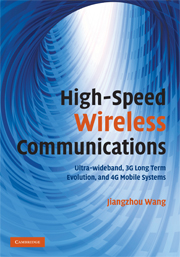Book contents
- Frontmatter
- Contents
- Preface
- Acknowledgements
- List of abbreviations
- Part I Introduction
- Part II UWB communications
- Part III Evolved 3G mobile communications
- 5 TD Receiver with ideal channel state information
- 6 TD receiver with imperfect channel estimation
- 7 QAM with antenna diversity
- 8 QAM for multicode CDMA with interference cancellation
- Part IV 4G mobile communications
- Index
- References
5 - TD Receiver with ideal channel state information
from Part III - Evolved 3G mobile communications
Published online by Cambridge University Press: 27 May 2010
- Frontmatter
- Contents
- Preface
- Acknowledgements
- List of abbreviations
- Part I Introduction
- Part II UWB communications
- Part III Evolved 3G mobile communications
- 5 TD Receiver with ideal channel state information
- 6 TD receiver with imperfect channel estimation
- 7 QAM with antenna diversity
- 8 QAM for multicode CDMA with interference cancellation
- Part IV 4G mobile communications
- Index
- References
Summary
In this chapter, TD performance is studied by assuming that the ideal channel state information is available at the receiver side. Under a frequency-selective Rayleigh fading environment, the performance of EGC and GSC 2D-Rake receivers is analyzed for either mutually independent or mutually correlated pairs of channels. The spatial diversity gain provided by TD-STBC is compared with that of a system deploying only one transmit antenna.
Introduction
It is assumed that the ideal channel state information (CSI) is available at the receiver, in other words, the channel estimation is perfect. The performance of the TD-STBC scheme is investigated in terms of the BER (bit error rate). In the next chapter, a common pilot signal transmission is employed to assist receivers in estimating the channel fading coefficients; hence, the impact of imperfect channel estimation on system performance can be investigated through comparing the results obtained in Chapters 5 and 6. The effect of correlation between the pair of channels from two transmit antennas to receive antenna is studied. In order to emphasize the spatial diversity gain from using TD-STBC, the performance of the corresponding Rake receiver of the conventional CDMA system with only one transmit antenna is evaluated and compared.
The rest of this chapter is organized as follows. In Section 5.2, the transmitter, channel and receiver models are described. The performance of coherent reception for downlink of the CDMA system with and without TD-STBC is analyzed in Section 5.3, and the closed-form expressions of BER are obtained.
- Type
- Chapter
- Information
- High-Speed Wireless CommunicationsUltra-wideband, 3G Long Term Evolution, and 4G Mobile Systems, pp. 117 - 169Publisher: Cambridge University PressPrint publication year: 2008



